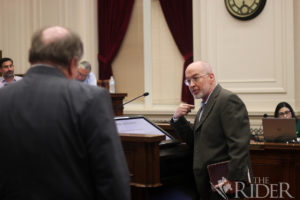During a public discussion on a proposed Rio Grande Valley Metropolitan Planning Organization, a Council of Governments official offered the Brownsville City Commission solutions to concerns with the plan.
On Tuesday, commissioners continued discussion on the MPO merger in a work session before the regular meeting.
Michael Morris, director of transportation for the Transportation Department of the North Central Texas Council of Governments, presented policy benefits of the proposed merger. According to the presentation, the benefits include:
–creating a larger “Transportation Management Area” status;
–moving to a correct geographic perspective;
–greater impact on gross domestic product;
–minimizing equity concerns;
–and expanding plans, programs, policies, performance, projects, partnerships and public.
The plan would merge the Brownsville, Hidalgo County and the Harlingen-San Benito MPOs.
In a Dec. 18 presentation, Pedro Alvarez, the district engineer for the Texas Department of Transportation’s Pharr District, listed pros and cons of a merger.
Pros include regional transportation planning, unified MPO planning, increased funding for Categories 2 and 7, and operational efficiencies. The proposed Rio Grande Valley MPO would be the fifth largest in Texas.
Cons include lost autonomy for individual MPOs, possible less funding for MPO administration and challenges for policy board members.
Alvarez said the biggest pro of the merger would be having a unified voice for the entire region with the con being loss of autonomy.
“Autonomy would be lost because now each of the individual [MPOs] would not be individual anymore,” he said. “However, the way to overcome that is to improve communication and ensuring that everybody expresses their concerns, expresses the need for the various projects and working together in partnership to develop projects as we move forward.”
MPOs are mandated by federal law with designated areas and where “all the state and federal funds are channeled through,” according to Pete Sepulveda, executive director of the Cameron County Regional Mobility Authority.
“The problem with having three separate MPOs is that you break up the population, and by breaking up the population, you reduce your chances of competing statewide, either for state funds or for federal funds,” Sepulveda said in a phone interview today with The Rider.
Category 2 is state funding and Category 7 is federal funding and are based on population.
“For example, Harlingen and San Benito, their population is very low, so they do not get any federal money,” he said. “Brownsville does because of their population, and Hidalgo County does because of their population, so unless there is a merger, Harlingen and San Benito will never be able to get Category 7 funding.”
Sepulveda said the proposed merger would give the regional MPO a “seat at the table” when funds are distributed on a statewide level.
Discussion on a city whistleblower policy and code of ethics were also items on Tuesday’s work session agenda but were not discussed.
“Just to let the public know, we will not be discussing letters B and C for the work session,” said Griselda Rosas, the city secretary.
The items are scheduled to be placed on the agenda for the Jan. 22 city commission meeting, according to Community Engagement Coordinator Christina Garza.
During their regular meeting, commissioners authorized City Manager Noel Bernal to sign an agreement between Brownsville Metro and Texas Southmost College to provide transportation services.
The pilot program started Wednesday and will continue until May 16.
TSC provided $20,241.17 to assist Brownsville Metro. The service includes 1,500 free rides for TSC students, faculty and staff who present a valid TSC ID. Free rides are available from Monday through Thursday and will cost 75 cents on Fridays and Saturdays.
The existing Route 14 was realigned and extended to four more hours from Monday through Thursday, according to agenda documents. Stops include the Brownsville & Matamoros International Bridge, International, Technology, Education and Commerce Center and Hope Park. The service is also open to the public at the regular $1 fee.
Robert Garza, assistant director of Brownsville Metro, said TSC students said the route did not connect with the ITECC building.
“The [students] that were doing studies there wanted to also transport all the way to TSC, so we began a discussion with TSC executives and we formed a committee with them,” Garza said. “They helped us subsidize the project.”
Garza said it is important for students to use the services in order to support the pilot program.
City commissioners also approved a resolution ordering a general municipal election to be held on May 4.
The positions up for election are mayor, city commissioner At-Large “A” and District 1 and 2 city commissioners.
Currently serving are Mayor Tony Martinez, who was first elected in 2011; At-Large Commissioner “A” Cesar De Leon, first elected in 2015; District 1 Commissioner Ricardo Longoria Jr., first elected in 2003; and, District 2 Commissioner Jessica Tetreau, first elected in 2011.
In other business, the commission:
–approved awarding a term contract to Galls Inc. for uniforms for the Brownsville Police Department
–reappointed Adrian Delgado to the Parks and Recreation Advisory Board Committee.






